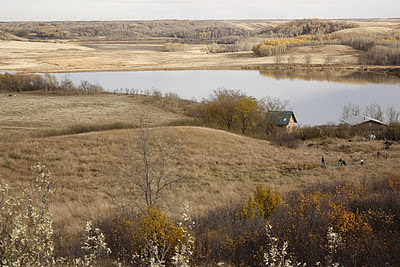
Upper Indian Head Creek Valley, above Cherry Lake
The warm, sunny days this fall have made up for the cool, wet spring, giving us some wonderful weather for walking the valley and prairie from our weekend community at Cherry Lake. The beavers have made six or seven lodges in the creek upstream of the lake, and you can see places on the valley walls where they've knocked aspen down in pick-up sticks piles. Late on Saturday afternoon we saw five bald eagles heading up the valley to their evening roost site, which they seem to use in late October as they migrate through the area.
As we walked to count eagles, a group of five ravens played on updrafts. Two moved in almost perfect tandem. I have trouble taking ravens seriously. The way these two moved, I swear they were not so much courting as teasing or putting on a mock ballet.

"One of those ravens is an eagle," Karen said, looking through her binoculars at the other three birds near the pair flying in tandem. I pointed the camera's big lens and took a shot, thinking it was a bald eagle, but when I got it onto the computer later I realized it was the much less common golden eagle. Only our second record in six years at Cherry Lake, it was a sub-adult, which you can see from the white areas limited to the base of the primary wing feathers and the tail.

The other identifying feature is the projection of the head compared to the tail. A bald eagle appears to be bigger in the head and shorter tailed.
As we approached the springs and pond at the head of the tributary where the eagles roost, we slowed down and kept quiet, but still flushed five eagles from their roost. All bald eagles, three were adults. The following shots show an adult that flew across the valley toward us and overhead into the fading sun.


The next day I took some shots of the valley hillsides and the marsh end of the lake.

looking up the valley from the end of the lake

the tawny grass in the foreground is Little Bluestem

The curled "prairie wool" of Blue Grama grass in fall

looking down on the lake and valley from the rim--you can see how the beavers have kept this part of the valley hillsides cropped short.

The people shown in the right middleground are digging up some of our last potatoes from a new patch in our upper alfalfa field.









